Analysis of Healthcare Human Resource Challenges in Canadian Nursing
VerifiedAdded on 2022/11/13
|12
|3453
|471
Essay
AI Summary
This assignment analyzes the human resource challenges faced by the Canadian healthcare system, focusing on issues within the nursing profession. The paper identifies key problems such as employee shortages, high turnover rates, and employee burnout, which are attributed to factors like an aging population, increased workload, and lack of training and development. The study uses academic literature to present a balanced view of the situation, discussing the impact of these challenges on healthcare service delivery, patient satisfaction, and the overall performance of the healthcare system. The paper also explores the root causes of these issues, including inadequate HR management, and suggests the need for effective leadership strategies to improve the situation. The analysis covers the financial and operational impacts of high turnover, the effects of burnout on patient care, and the importance of addressing these issues to ensure a sustainable and efficient healthcare system in Canada. The assignment aims to provide a comprehensive overview of the challenges and potential solutions for healthcare human resource management.
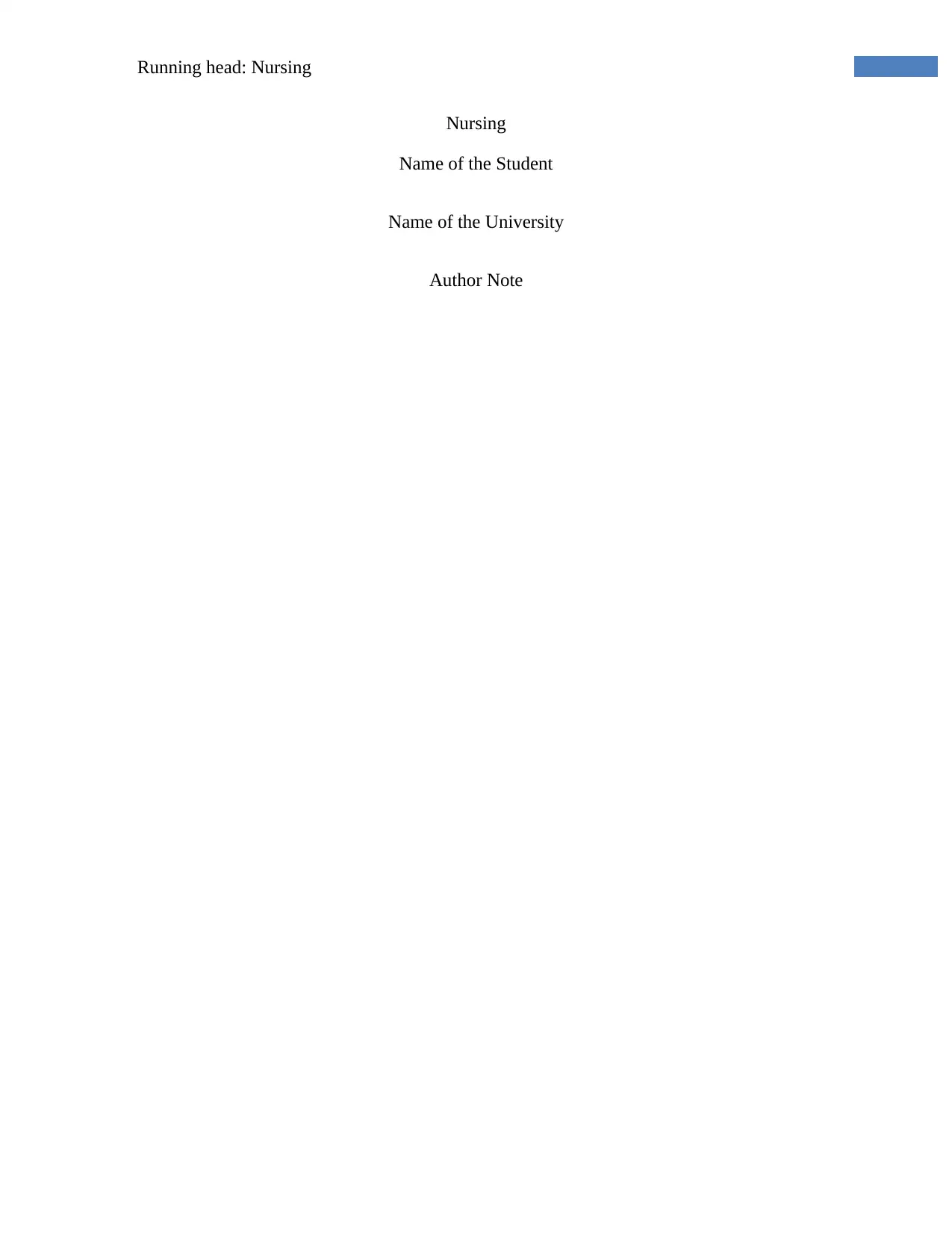
1Running head: Nursing
Nursing
Name of the Student
Name of the University
Author Note
Nursing
Name of the Student
Name of the University
Author Note
Paraphrase This Document
Need a fresh take? Get an instant paraphrase of this document with our AI Paraphraser
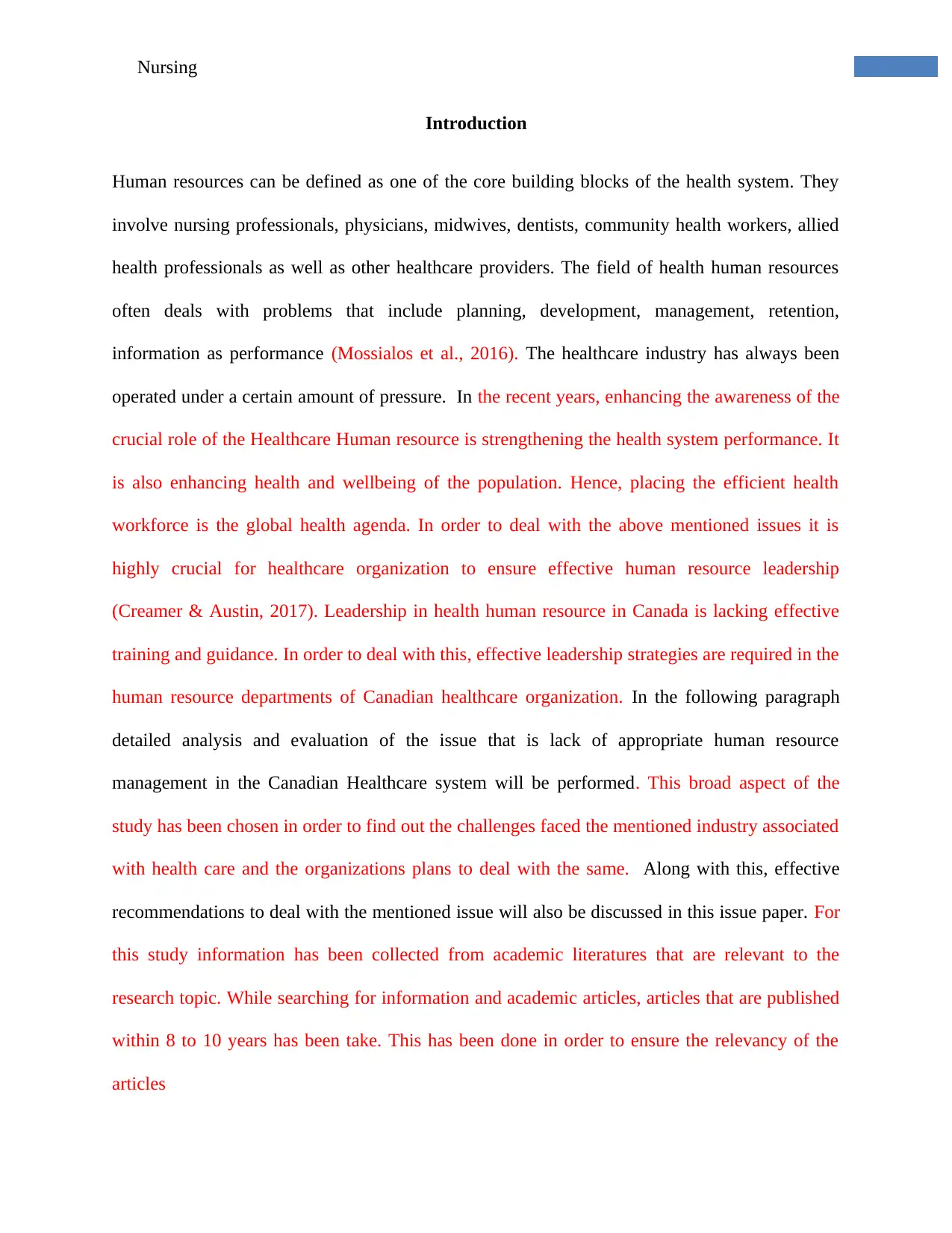
2Nursing
Introduction
Human resources can be defined as one of the core building blocks of the health system. They
involve nursing professionals, physicians, midwives, dentists, community health workers, allied
health professionals as well as other healthcare providers. The field of health human resources
often deals with problems that include planning, development, management, retention,
information as performance (Mossialos et al., 2016). The healthcare industry has always been
operated under a certain amount of pressure. In the recent years, enhancing the awareness of the
crucial role of the Healthcare Human resource is strengthening the health system performance. It
is also enhancing health and wellbeing of the population. Hence, placing the efficient health
workforce is the global health agenda. In order to deal with the above mentioned issues it is
highly crucial for healthcare organization to ensure effective human resource leadership
(Creamer & Austin, 2017). Leadership in health human resource in Canada is lacking effective
training and guidance. In order to deal with this, effective leadership strategies are required in the
human resource departments of Canadian healthcare organization. In the following paragraph
detailed analysis and evaluation of the issue that is lack of appropriate human resource
management in the Canadian Healthcare system will be performed. This broad aspect of the
study has been chosen in order to find out the challenges faced the mentioned industry associated
with health care and the organizations plans to deal with the same. Along with this, effective
recommendations to deal with the mentioned issue will also be discussed in this issue paper. For
this study information has been collected from academic literatures that are relevant to the
research topic. While searching for information and academic articles, articles that are published
within 8 to 10 years has been take. This has been done in order to ensure the relevancy of the
articles
Introduction
Human resources can be defined as one of the core building blocks of the health system. They
involve nursing professionals, physicians, midwives, dentists, community health workers, allied
health professionals as well as other healthcare providers. The field of health human resources
often deals with problems that include planning, development, management, retention,
information as performance (Mossialos et al., 2016). The healthcare industry has always been
operated under a certain amount of pressure. In the recent years, enhancing the awareness of the
crucial role of the Healthcare Human resource is strengthening the health system performance. It
is also enhancing health and wellbeing of the population. Hence, placing the efficient health
workforce is the global health agenda. In order to deal with the above mentioned issues it is
highly crucial for healthcare organization to ensure effective human resource leadership
(Creamer & Austin, 2017). Leadership in health human resource in Canada is lacking effective
training and guidance. In order to deal with this, effective leadership strategies are required in the
human resource departments of Canadian healthcare organization. In the following paragraph
detailed analysis and evaluation of the issue that is lack of appropriate human resource
management in the Canadian Healthcare system will be performed. This broad aspect of the
study has been chosen in order to find out the challenges faced the mentioned industry associated
with health care and the organizations plans to deal with the same. Along with this, effective
recommendations to deal with the mentioned issue will also be discussed in this issue paper. For
this study information has been collected from academic literatures that are relevant to the
research topic. While searching for information and academic articles, articles that are published
within 8 to 10 years has been take. This has been done in order to ensure the relevancy of the
articles
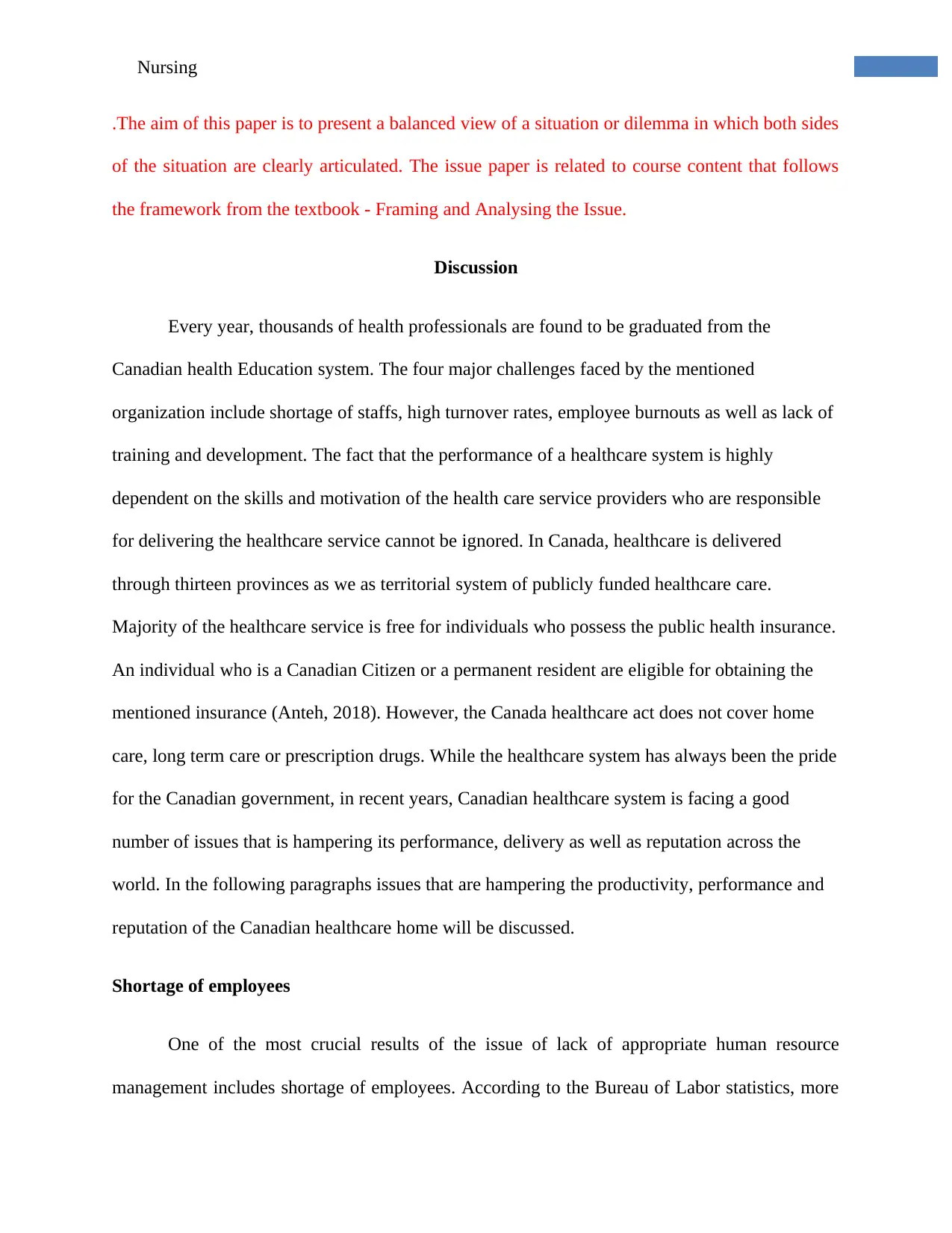
3Nursing
.The aim of this paper is to present a balanced view of a situation or dilemma in which both sides
of the situation are clearly articulated. The issue paper is related to course content that follows
the framework from the textbook - Framing and Analysing the Issue.
Discussion
Every year, thousands of health professionals are found to be graduated from the
Canadian health Education system. The four major challenges faced by the mentioned
organization include shortage of staffs, high turnover rates, employee burnouts as well as lack of
training and development. The fact that the performance of a healthcare system is highly
dependent on the skills and motivation of the health care service providers who are responsible
for delivering the healthcare service cannot be ignored. In Canada, healthcare is delivered
through thirteen provinces as we as territorial system of publicly funded healthcare care.
Majority of the healthcare service is free for individuals who possess the public health insurance.
An individual who is a Canadian Citizen or a permanent resident are eligible for obtaining the
mentioned insurance (Anteh, 2018). However, the Canada healthcare act does not cover home
care, long term care or prescription drugs. While the healthcare system has always been the pride
for the Canadian government, in recent years, Canadian healthcare system is facing a good
number of issues that is hampering its performance, delivery as well as reputation across the
world. In the following paragraphs issues that are hampering the productivity, performance and
reputation of the Canadian healthcare home will be discussed.
Shortage of employees
One of the most crucial results of the issue of lack of appropriate human resource
management includes shortage of employees. According to the Bureau of Labor statistics, more
.The aim of this paper is to present a balanced view of a situation or dilemma in which both sides
of the situation are clearly articulated. The issue paper is related to course content that follows
the framework from the textbook - Framing and Analysing the Issue.
Discussion
Every year, thousands of health professionals are found to be graduated from the
Canadian health Education system. The four major challenges faced by the mentioned
organization include shortage of staffs, high turnover rates, employee burnouts as well as lack of
training and development. The fact that the performance of a healthcare system is highly
dependent on the skills and motivation of the health care service providers who are responsible
for delivering the healthcare service cannot be ignored. In Canada, healthcare is delivered
through thirteen provinces as we as territorial system of publicly funded healthcare care.
Majority of the healthcare service is free for individuals who possess the public health insurance.
An individual who is a Canadian Citizen or a permanent resident are eligible for obtaining the
mentioned insurance (Anteh, 2018). However, the Canada healthcare act does not cover home
care, long term care or prescription drugs. While the healthcare system has always been the pride
for the Canadian government, in recent years, Canadian healthcare system is facing a good
number of issues that is hampering its performance, delivery as well as reputation across the
world. In the following paragraphs issues that are hampering the productivity, performance and
reputation of the Canadian healthcare home will be discussed.
Shortage of employees
One of the most crucial results of the issue of lack of appropriate human resource
management includes shortage of employees. According to the Bureau of Labor statistics, more
⊘ This is a preview!⊘
Do you want full access?
Subscribe today to unlock all pages.

Trusted by 1+ million students worldwide
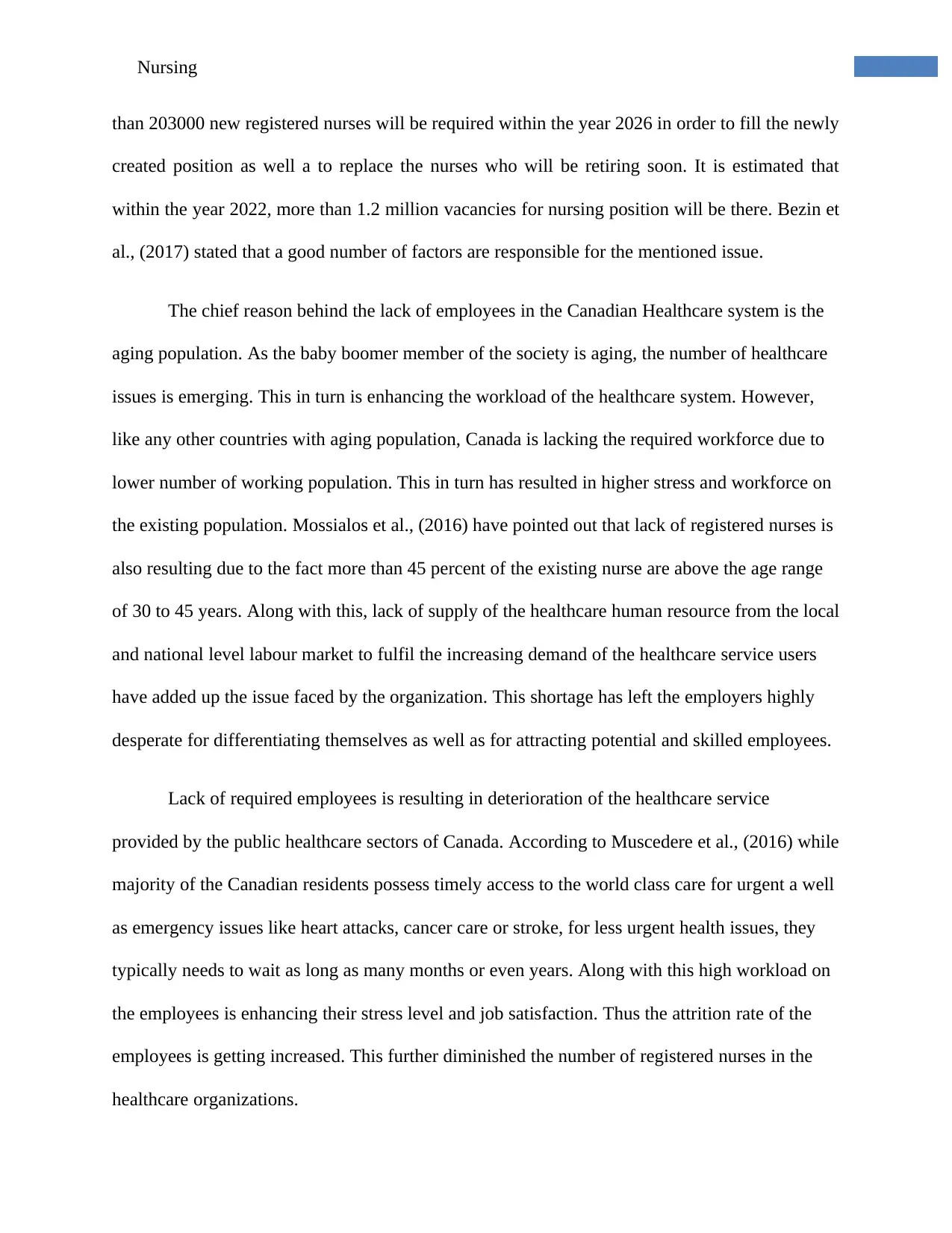
4Nursing
than 203000 new registered nurses will be required within the year 2026 in order to fill the newly
created position as well a to replace the nurses who will be retiring soon. It is estimated that
within the year 2022, more than 1.2 million vacancies for nursing position will be there. Bezin et
al., (2017) stated that a good number of factors are responsible for the mentioned issue.
The chief reason behind the lack of employees in the Canadian Healthcare system is the
aging population. As the baby boomer member of the society is aging, the number of healthcare
issues is emerging. This in turn is enhancing the workload of the healthcare system. However,
like any other countries with aging population, Canada is lacking the required workforce due to
lower number of working population. This in turn has resulted in higher stress and workforce on
the existing population. Mossialos et al., (2016) have pointed out that lack of registered nurses is
also resulting due to the fact more than 45 percent of the existing nurse are above the age range
of 30 to 45 years. Along with this, lack of supply of the healthcare human resource from the local
and national level labour market to fulfil the increasing demand of the healthcare service users
have added up the issue faced by the organization. This shortage has left the employers highly
desperate for differentiating themselves as well as for attracting potential and skilled employees.
Lack of required employees is resulting in deterioration of the healthcare service
provided by the public healthcare sectors of Canada. According to Muscedere et al., (2016) while
majority of the Canadian residents possess timely access to the world class care for urgent a well
as emergency issues like heart attacks, cancer care or stroke, for less urgent health issues, they
typically needs to wait as long as many months or even years. Along with this high workload on
the employees is enhancing their stress level and job satisfaction. Thus the attrition rate of the
employees is getting increased. This further diminished the number of registered nurses in the
healthcare organizations.
than 203000 new registered nurses will be required within the year 2026 in order to fill the newly
created position as well a to replace the nurses who will be retiring soon. It is estimated that
within the year 2022, more than 1.2 million vacancies for nursing position will be there. Bezin et
al., (2017) stated that a good number of factors are responsible for the mentioned issue.
The chief reason behind the lack of employees in the Canadian Healthcare system is the
aging population. As the baby boomer member of the society is aging, the number of healthcare
issues is emerging. This in turn is enhancing the workload of the healthcare system. However,
like any other countries with aging population, Canada is lacking the required workforce due to
lower number of working population. This in turn has resulted in higher stress and workforce on
the existing population. Mossialos et al., (2016) have pointed out that lack of registered nurses is
also resulting due to the fact more than 45 percent of the existing nurse are above the age range
of 30 to 45 years. Along with this, lack of supply of the healthcare human resource from the local
and national level labour market to fulfil the increasing demand of the healthcare service users
have added up the issue faced by the organization. This shortage has left the employers highly
desperate for differentiating themselves as well as for attracting potential and skilled employees.
Lack of required employees is resulting in deterioration of the healthcare service
provided by the public healthcare sectors of Canada. According to Muscedere et al., (2016) while
majority of the Canadian residents possess timely access to the world class care for urgent a well
as emergency issues like heart attacks, cancer care or stroke, for less urgent health issues, they
typically needs to wait as long as many months or even years. Along with this high workload on
the employees is enhancing their stress level and job satisfaction. Thus the attrition rate of the
employees is getting increased. This further diminished the number of registered nurses in the
healthcare organizations.
Paraphrase This Document
Need a fresh take? Get an instant paraphrase of this document with our AI Paraphraser
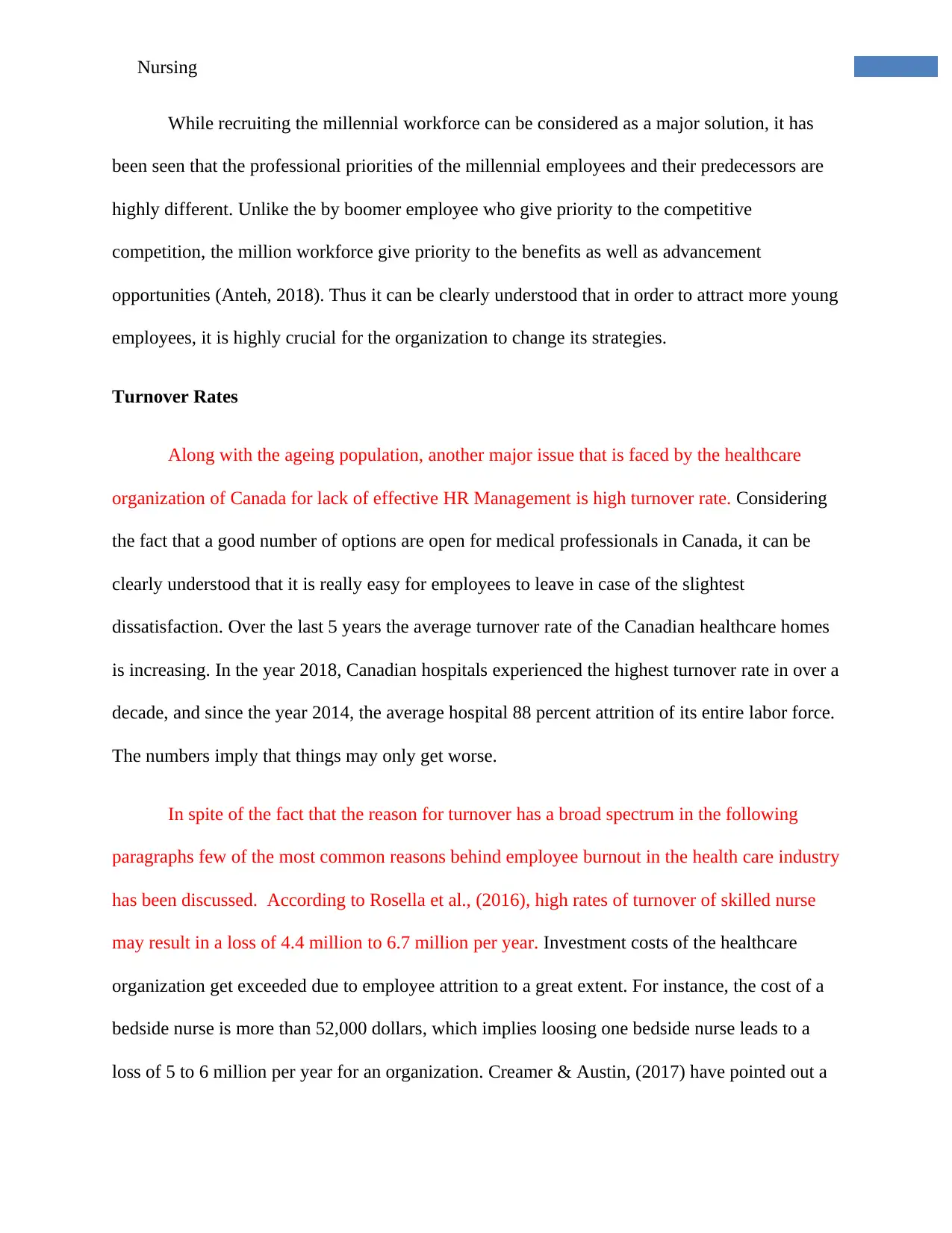
5Nursing
While recruiting the millennial workforce can be considered as a major solution, it has
been seen that the professional priorities of the millennial employees and their predecessors are
highly different. Unlike the by boomer employee who give priority to the competitive
competition, the million workforce give priority to the benefits as well as advancement
opportunities (Anteh, 2018). Thus it can be clearly understood that in order to attract more young
employees, it is highly crucial for the organization to change its strategies.
Turnover Rates
Along with the ageing population, another major issue that is faced by the healthcare
organization of Canada for lack of effective HR Management is high turnover rate. Considering
the fact that a good number of options are open for medical professionals in Canada, it can be
clearly understood that it is really easy for employees to leave in case of the slightest
dissatisfaction. Over the last 5 years the average turnover rate of the Canadian healthcare homes
is increasing. In the year 2018, Canadian hospitals experienced the highest turnover rate in over a
decade, and since the year 2014, the average hospital 88 percent attrition of its entire labor force.
The numbers imply that things may only get worse.
In spite of the fact that the reason for turnover has a broad spectrum in the following
paragraphs few of the most common reasons behind employee burnout in the health care industry
has been discussed. According to Rosella et al., (2016), high rates of turnover of skilled nurse
may result in a loss of 4.4 million to 6.7 million per year. Investment costs of the healthcare
organization get exceeded due to employee attrition to a great extent. For instance, the cost of a
bedside nurse is more than 52,000 dollars, which implies loosing one bedside nurse leads to a
loss of 5 to 6 million per year for an organization. Creamer & Austin, (2017) have pointed out a
While recruiting the millennial workforce can be considered as a major solution, it has
been seen that the professional priorities of the millennial employees and their predecessors are
highly different. Unlike the by boomer employee who give priority to the competitive
competition, the million workforce give priority to the benefits as well as advancement
opportunities (Anteh, 2018). Thus it can be clearly understood that in order to attract more young
employees, it is highly crucial for the organization to change its strategies.
Turnover Rates
Along with the ageing population, another major issue that is faced by the healthcare
organization of Canada for lack of effective HR Management is high turnover rate. Considering
the fact that a good number of options are open for medical professionals in Canada, it can be
clearly understood that it is really easy for employees to leave in case of the slightest
dissatisfaction. Over the last 5 years the average turnover rate of the Canadian healthcare homes
is increasing. In the year 2018, Canadian hospitals experienced the highest turnover rate in over a
decade, and since the year 2014, the average hospital 88 percent attrition of its entire labor force.
The numbers imply that things may only get worse.
In spite of the fact that the reason for turnover has a broad spectrum in the following
paragraphs few of the most common reasons behind employee burnout in the health care industry
has been discussed. According to Rosella et al., (2016), high rates of turnover of skilled nurse
may result in a loss of 4.4 million to 6.7 million per year. Investment costs of the healthcare
organization get exceeded due to employee attrition to a great extent. For instance, the cost of a
bedside nurse is more than 52,000 dollars, which implies loosing one bedside nurse leads to a
loss of 5 to 6 million per year for an organization. Creamer & Austin, (2017) have pointed out a
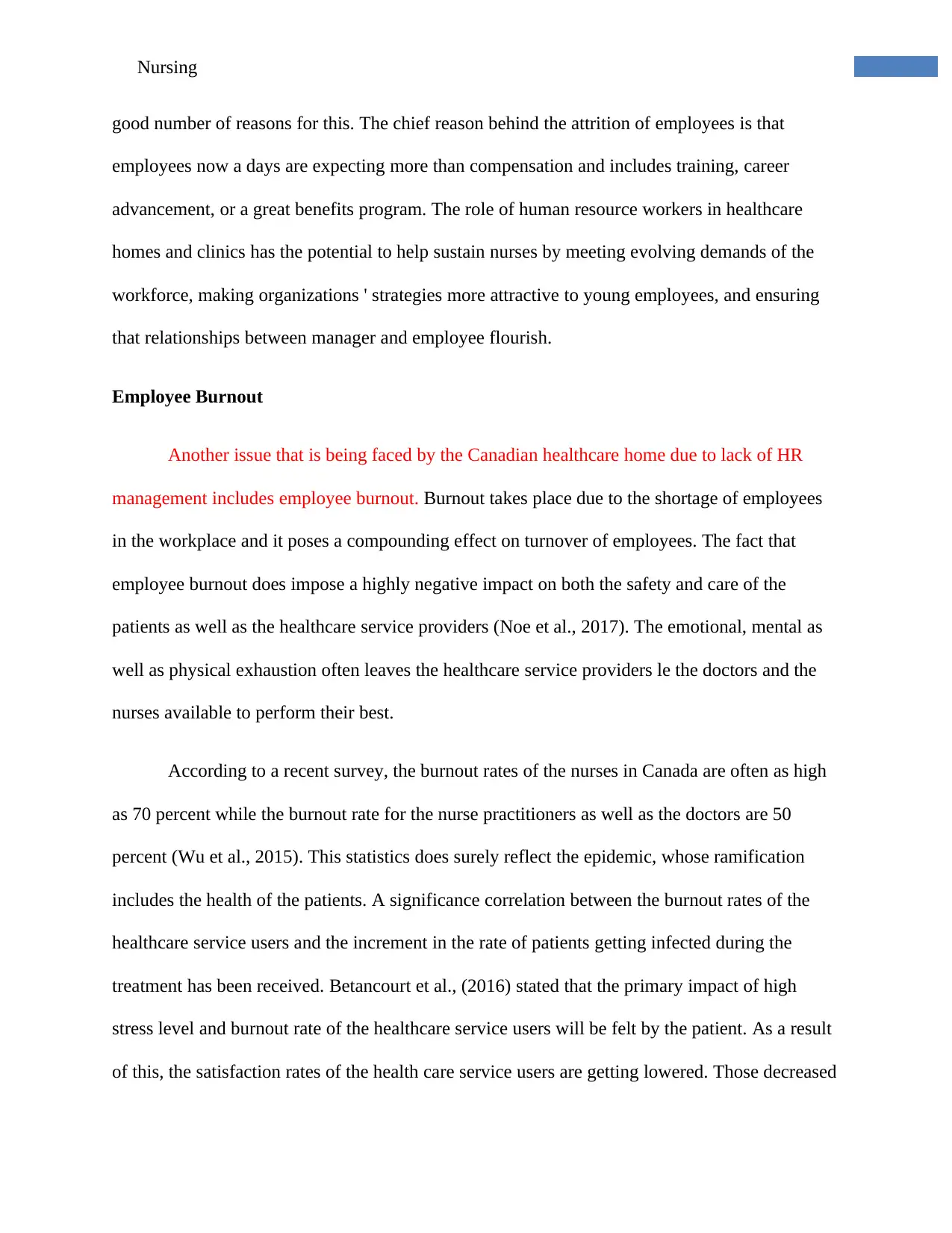
6Nursing
good number of reasons for this. The chief reason behind the attrition of employees is that
employees now a days are expecting more than compensation and includes training, career
advancement, or a great benefits program. The role of human resource workers in healthcare
homes and clinics has the potential to help sustain nurses by meeting evolving demands of the
workforce, making organizations ' strategies more attractive to young employees, and ensuring
that relationships between manager and employee flourish.
Employee Burnout
Another issue that is being faced by the Canadian healthcare home due to lack of HR
management includes employee burnout. Burnout takes place due to the shortage of employees
in the workplace and it poses a compounding effect on turnover of employees. The fact that
employee burnout does impose a highly negative impact on both the safety and care of the
patients as well as the healthcare service providers (Noe et al., 2017). The emotional, mental as
well as physical exhaustion often leaves the healthcare service providers le the doctors and the
nurses available to perform their best.
According to a recent survey, the burnout rates of the nurses in Canada are often as high
as 70 percent while the burnout rate for the nurse practitioners as well as the doctors are 50
percent (Wu et al., 2015). This statistics does surely reflect the epidemic, whose ramification
includes the health of the patients. A significance correlation between the burnout rates of the
healthcare service users and the increment in the rate of patients getting infected during the
treatment has been received. Betancourt et al., (2016) stated that the primary impact of high
stress level and burnout rate of the healthcare service users will be felt by the patient. As a result
of this, the satisfaction rates of the health care service users are getting lowered. Those decreased
good number of reasons for this. The chief reason behind the attrition of employees is that
employees now a days are expecting more than compensation and includes training, career
advancement, or a great benefits program. The role of human resource workers in healthcare
homes and clinics has the potential to help sustain nurses by meeting evolving demands of the
workforce, making organizations ' strategies more attractive to young employees, and ensuring
that relationships between manager and employee flourish.
Employee Burnout
Another issue that is being faced by the Canadian healthcare home due to lack of HR
management includes employee burnout. Burnout takes place due to the shortage of employees
in the workplace and it poses a compounding effect on turnover of employees. The fact that
employee burnout does impose a highly negative impact on both the safety and care of the
patients as well as the healthcare service providers (Noe et al., 2017). The emotional, mental as
well as physical exhaustion often leaves the healthcare service providers le the doctors and the
nurses available to perform their best.
According to a recent survey, the burnout rates of the nurses in Canada are often as high
as 70 percent while the burnout rate for the nurse practitioners as well as the doctors are 50
percent (Wu et al., 2015). This statistics does surely reflect the epidemic, whose ramification
includes the health of the patients. A significance correlation between the burnout rates of the
healthcare service users and the increment in the rate of patients getting infected during the
treatment has been received. Betancourt et al., (2016) stated that the primary impact of high
stress level and burnout rate of the healthcare service users will be felt by the patient. As a result
of this, the satisfaction rates of the health care service users are getting lowered. Those decreased
⊘ This is a preview!⊘
Do you want full access?
Subscribe today to unlock all pages.

Trusted by 1+ million students worldwide
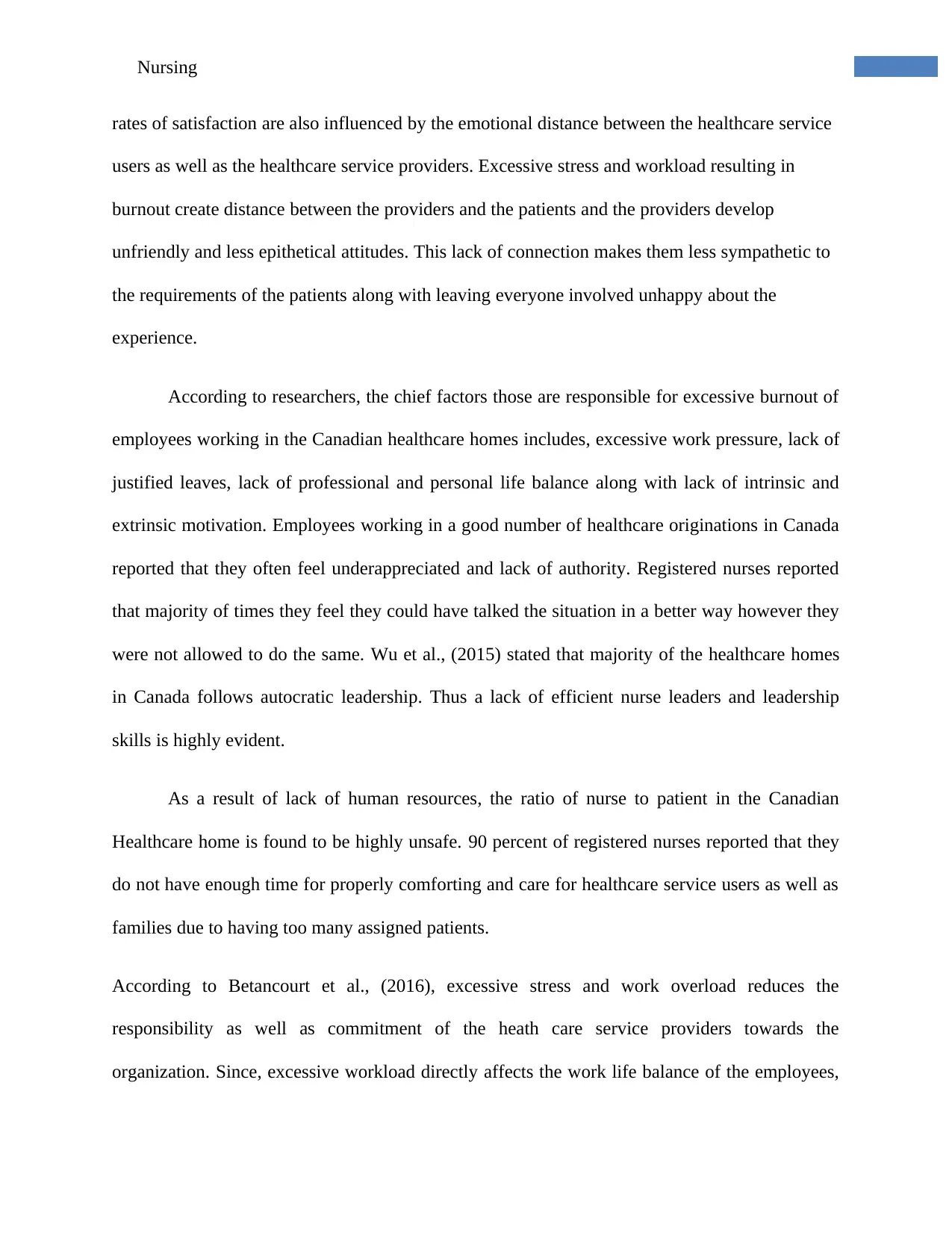
7Nursing
rates of satisfaction are also influenced by the emotional distance between the healthcare service
users as well as the healthcare service providers. Excessive stress and workload resulting in
burnout create distance between the providers and the patients and the providers develop
unfriendly and less epithetical attitudes. This lack of connection makes them less sympathetic to
the requirements of the patients along with leaving everyone involved unhappy about the
experience.
According to researchers, the chief factors those are responsible for excessive burnout of
employees working in the Canadian healthcare homes includes, excessive work pressure, lack of
justified leaves, lack of professional and personal life balance along with lack of intrinsic and
extrinsic motivation. Employees working in a good number of healthcare originations in Canada
reported that they often feel underappreciated and lack of authority. Registered nurses reported
that majority of times they feel they could have talked the situation in a better way however they
were not allowed to do the same. Wu et al., (2015) stated that majority of the healthcare homes
in Canada follows autocratic leadership. Thus a lack of efficient nurse leaders and leadership
skills is highly evident.
As a result of lack of human resources, the ratio of nurse to patient in the Canadian
Healthcare home is found to be highly unsafe. 90 percent of registered nurses reported that they
do not have enough time for properly comforting and care for healthcare service users as well as
families due to having too many assigned patients.
According to Betancourt et al., (2016), excessive stress and work overload reduces the
responsibility as well as commitment of the heath care service providers towards the
organization. Since, excessive workload directly affects the work life balance of the employees,
rates of satisfaction are also influenced by the emotional distance between the healthcare service
users as well as the healthcare service providers. Excessive stress and workload resulting in
burnout create distance between the providers and the patients and the providers develop
unfriendly and less epithetical attitudes. This lack of connection makes them less sympathetic to
the requirements of the patients along with leaving everyone involved unhappy about the
experience.
According to researchers, the chief factors those are responsible for excessive burnout of
employees working in the Canadian healthcare homes includes, excessive work pressure, lack of
justified leaves, lack of professional and personal life balance along with lack of intrinsic and
extrinsic motivation. Employees working in a good number of healthcare originations in Canada
reported that they often feel underappreciated and lack of authority. Registered nurses reported
that majority of times they feel they could have talked the situation in a better way however they
were not allowed to do the same. Wu et al., (2015) stated that majority of the healthcare homes
in Canada follows autocratic leadership. Thus a lack of efficient nurse leaders and leadership
skills is highly evident.
As a result of lack of human resources, the ratio of nurse to patient in the Canadian
Healthcare home is found to be highly unsafe. 90 percent of registered nurses reported that they
do not have enough time for properly comforting and care for healthcare service users as well as
families due to having too many assigned patients.
According to Betancourt et al., (2016), excessive stress and work overload reduces the
responsibility as well as commitment of the heath care service providers towards the
organization. Since, excessive workload directly affects the work life balance of the employees,
Paraphrase This Document
Need a fresh take? Get an instant paraphrase of this document with our AI Paraphraser
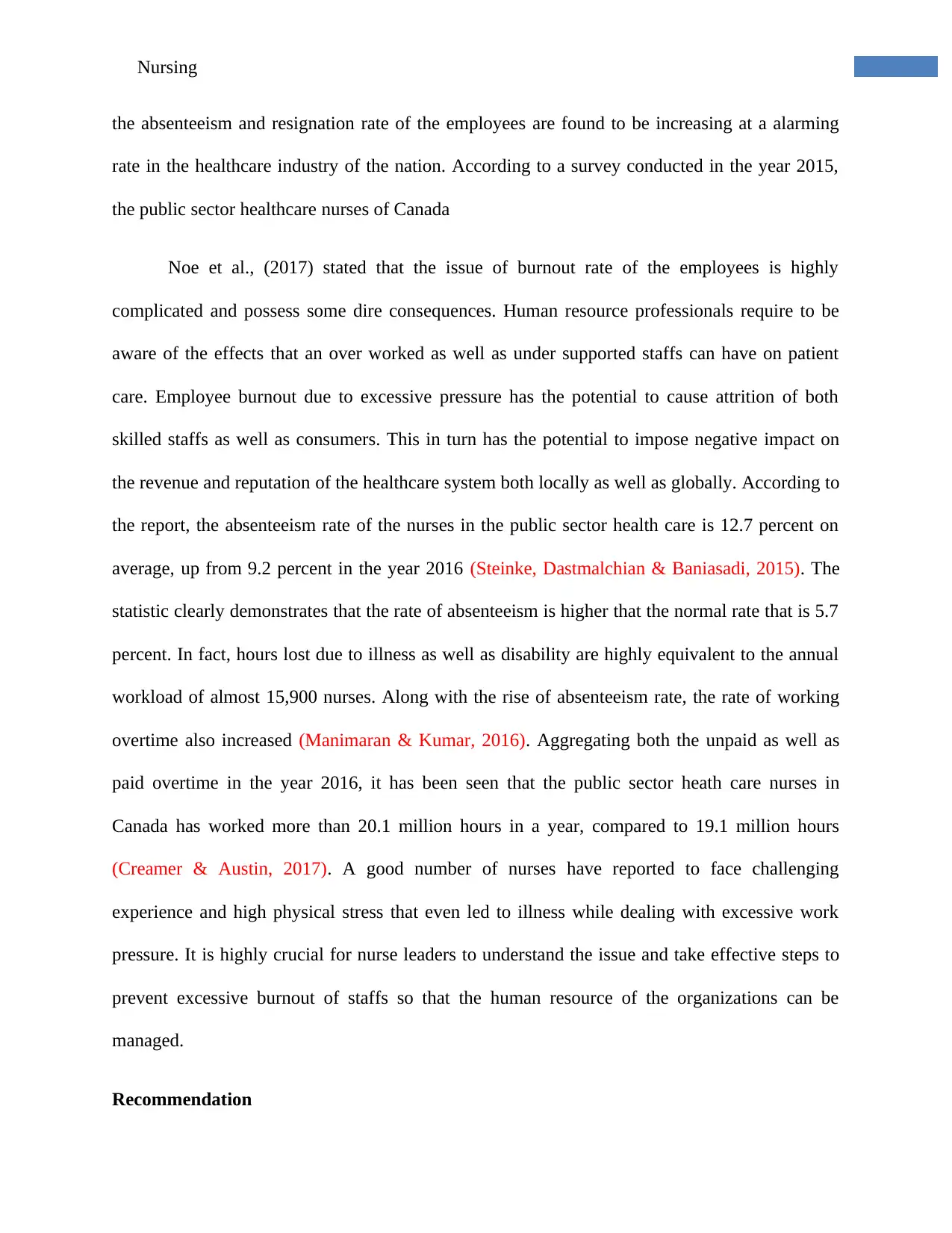
8Nursing
the absenteeism and resignation rate of the employees are found to be increasing at a alarming
rate in the healthcare industry of the nation. According to a survey conducted in the year 2015,
the public sector healthcare nurses of Canada
Noe et al., (2017) stated that the issue of burnout rate of the employees is highly
complicated and possess some dire consequences. Human resource professionals require to be
aware of the effects that an over worked as well as under supported staffs can have on patient
care. Employee burnout due to excessive pressure has the potential to cause attrition of both
skilled staffs as well as consumers. This in turn has the potential to impose negative impact on
the revenue and reputation of the healthcare system both locally as well as globally. According to
the report, the absenteeism rate of the nurses in the public sector health care is 12.7 percent on
average, up from 9.2 percent in the year 2016 (Steinke, Dastmalchian & Baniasadi, 2015). The
statistic clearly demonstrates that the rate of absenteeism is higher that the normal rate that is 5.7
percent. In fact, hours lost due to illness as well as disability are highly equivalent to the annual
workload of almost 15,900 nurses. Along with the rise of absenteeism rate, the rate of working
overtime also increased (Manimaran & Kumar, 2016). Aggregating both the unpaid as well as
paid overtime in the year 2016, it has been seen that the public sector heath care nurses in
Canada has worked more than 20.1 million hours in a year, compared to 19.1 million hours
(Creamer & Austin, 2017). A good number of nurses have reported to face challenging
experience and high physical stress that even led to illness while dealing with excessive work
pressure. It is highly crucial for nurse leaders to understand the issue and take effective steps to
prevent excessive burnout of staffs so that the human resource of the organizations can be
managed.
Recommendation
the absenteeism and resignation rate of the employees are found to be increasing at a alarming
rate in the healthcare industry of the nation. According to a survey conducted in the year 2015,
the public sector healthcare nurses of Canada
Noe et al., (2017) stated that the issue of burnout rate of the employees is highly
complicated and possess some dire consequences. Human resource professionals require to be
aware of the effects that an over worked as well as under supported staffs can have on patient
care. Employee burnout due to excessive pressure has the potential to cause attrition of both
skilled staffs as well as consumers. This in turn has the potential to impose negative impact on
the revenue and reputation of the healthcare system both locally as well as globally. According to
the report, the absenteeism rate of the nurses in the public sector health care is 12.7 percent on
average, up from 9.2 percent in the year 2016 (Steinke, Dastmalchian & Baniasadi, 2015). The
statistic clearly demonstrates that the rate of absenteeism is higher that the normal rate that is 5.7
percent. In fact, hours lost due to illness as well as disability are highly equivalent to the annual
workload of almost 15,900 nurses. Along with the rise of absenteeism rate, the rate of working
overtime also increased (Manimaran & Kumar, 2016). Aggregating both the unpaid as well as
paid overtime in the year 2016, it has been seen that the public sector heath care nurses in
Canada has worked more than 20.1 million hours in a year, compared to 19.1 million hours
(Creamer & Austin, 2017). A good number of nurses have reported to face challenging
experience and high physical stress that even led to illness while dealing with excessive work
pressure. It is highly crucial for nurse leaders to understand the issue and take effective steps to
prevent excessive burnout of staffs so that the human resource of the organizations can be
managed.
Recommendation
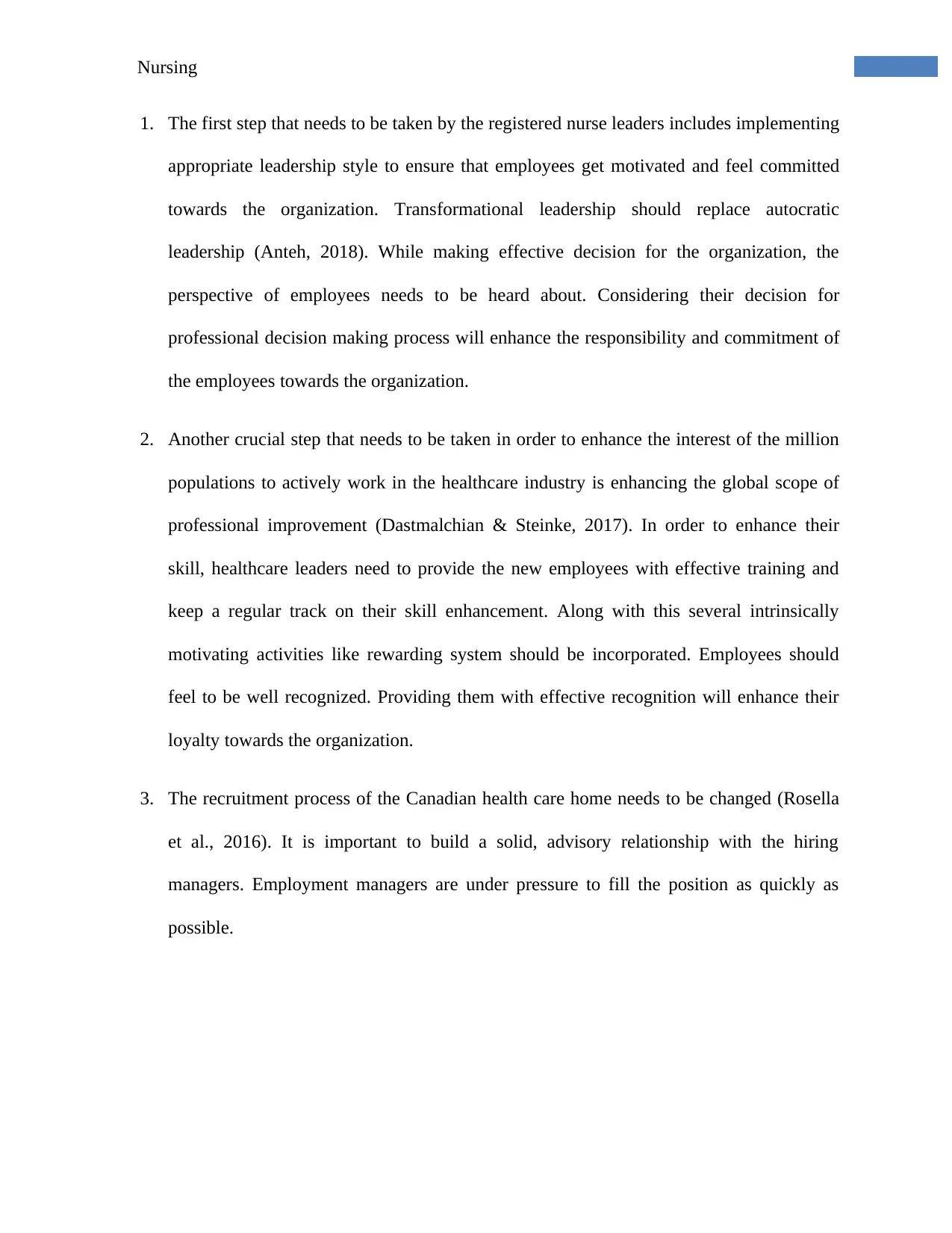
9Nursing
1. The first step that needs to be taken by the registered nurse leaders includes implementing
appropriate leadership style to ensure that employees get motivated and feel committed
towards the organization. Transformational leadership should replace autocratic
leadership (Anteh, 2018). While making effective decision for the organization, the
perspective of employees needs to be heard about. Considering their decision for
professional decision making process will enhance the responsibility and commitment of
the employees towards the organization.
2. Another crucial step that needs to be taken in order to enhance the interest of the million
populations to actively work in the healthcare industry is enhancing the global scope of
professional improvement (Dastmalchian & Steinke, 2017). In order to enhance their
skill, healthcare leaders need to provide the new employees with effective training and
keep a regular track on their skill enhancement. Along with this several intrinsically
motivating activities like rewarding system should be incorporated. Employees should
feel to be well recognized. Providing them with effective recognition will enhance their
loyalty towards the organization.
3. The recruitment process of the Canadian health care home needs to be changed (Rosella
et al., 2016). It is important to build a solid, advisory relationship with the hiring
managers. Employment managers are under pressure to fill the position as quickly as
possible.
1. The first step that needs to be taken by the registered nurse leaders includes implementing
appropriate leadership style to ensure that employees get motivated and feel committed
towards the organization. Transformational leadership should replace autocratic
leadership (Anteh, 2018). While making effective decision for the organization, the
perspective of employees needs to be heard about. Considering their decision for
professional decision making process will enhance the responsibility and commitment of
the employees towards the organization.
2. Another crucial step that needs to be taken in order to enhance the interest of the million
populations to actively work in the healthcare industry is enhancing the global scope of
professional improvement (Dastmalchian & Steinke, 2017). In order to enhance their
skill, healthcare leaders need to provide the new employees with effective training and
keep a regular track on their skill enhancement. Along with this several intrinsically
motivating activities like rewarding system should be incorporated. Employees should
feel to be well recognized. Providing them with effective recognition will enhance their
loyalty towards the organization.
3. The recruitment process of the Canadian health care home needs to be changed (Rosella
et al., 2016). It is important to build a solid, advisory relationship with the hiring
managers. Employment managers are under pressure to fill the position as quickly as
possible.
⊘ This is a preview!⊘
Do you want full access?
Subscribe today to unlock all pages.

Trusted by 1+ million students worldwide
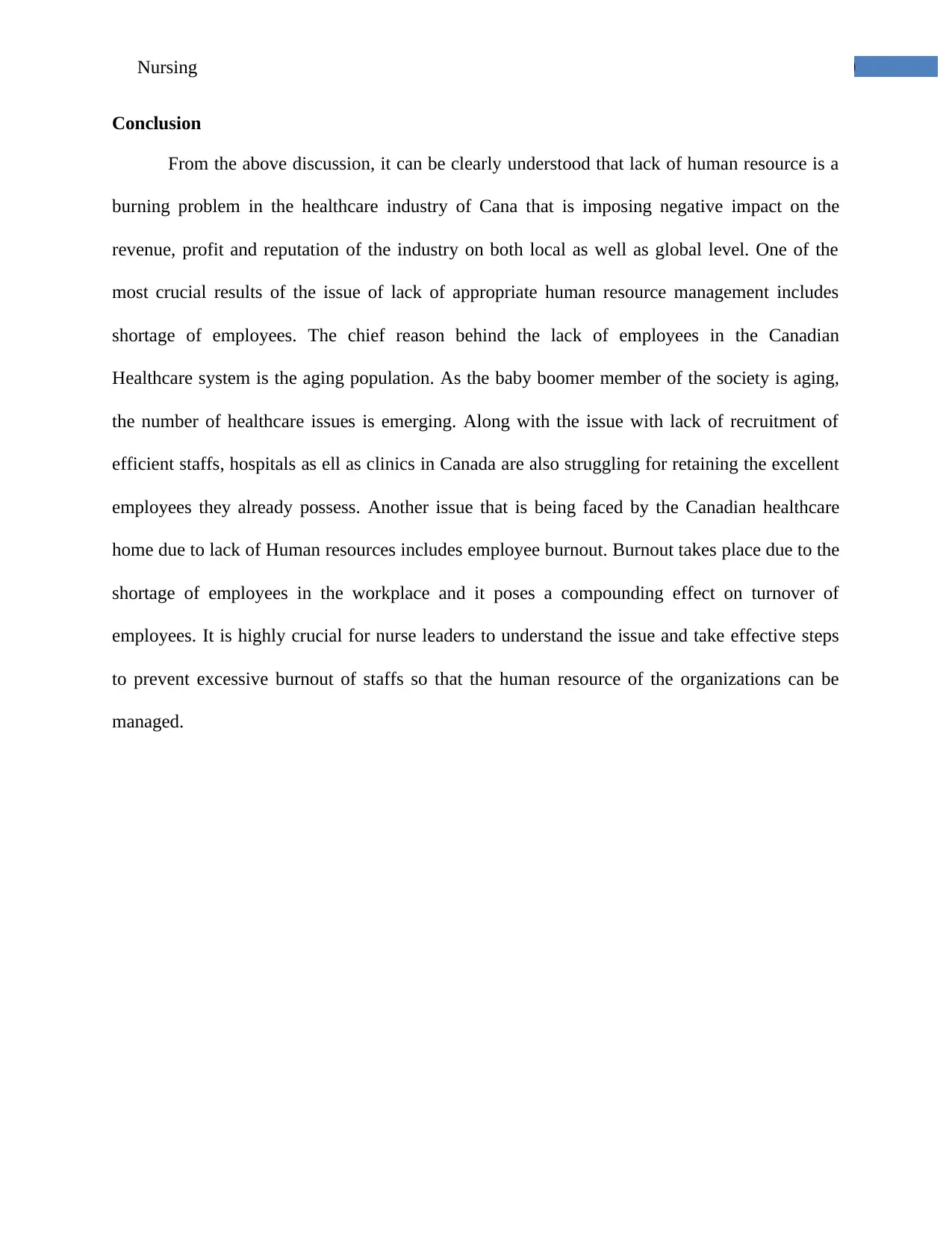
10Nursing
Conclusion
From the above discussion, it can be clearly understood that lack of human resource is a
burning problem in the healthcare industry of Cana that is imposing negative impact on the
revenue, profit and reputation of the industry on both local as well as global level. One of the
most crucial results of the issue of lack of appropriate human resource management includes
shortage of employees. The chief reason behind the lack of employees in the Canadian
Healthcare system is the aging population. As the baby boomer member of the society is aging,
the number of healthcare issues is emerging. Along with the issue with lack of recruitment of
efficient staffs, hospitals as ell as clinics in Canada are also struggling for retaining the excellent
employees they already possess. Another issue that is being faced by the Canadian healthcare
home due to lack of Human resources includes employee burnout. Burnout takes place due to the
shortage of employees in the workplace and it poses a compounding effect on turnover of
employees. It is highly crucial for nurse leaders to understand the issue and take effective steps
to prevent excessive burnout of staffs so that the human resource of the organizations can be
managed.
Conclusion
From the above discussion, it can be clearly understood that lack of human resource is a
burning problem in the healthcare industry of Cana that is imposing negative impact on the
revenue, profit and reputation of the industry on both local as well as global level. One of the
most crucial results of the issue of lack of appropriate human resource management includes
shortage of employees. The chief reason behind the lack of employees in the Canadian
Healthcare system is the aging population. As the baby boomer member of the society is aging,
the number of healthcare issues is emerging. Along with the issue with lack of recruitment of
efficient staffs, hospitals as ell as clinics in Canada are also struggling for retaining the excellent
employees they already possess. Another issue that is being faced by the Canadian healthcare
home due to lack of Human resources includes employee burnout. Burnout takes place due to the
shortage of employees in the workplace and it poses a compounding effect on turnover of
employees. It is highly crucial for nurse leaders to understand the issue and take effective steps
to prevent excessive burnout of staffs so that the human resource of the organizations can be
managed.
Paraphrase This Document
Need a fresh take? Get an instant paraphrase of this document with our AI Paraphraser
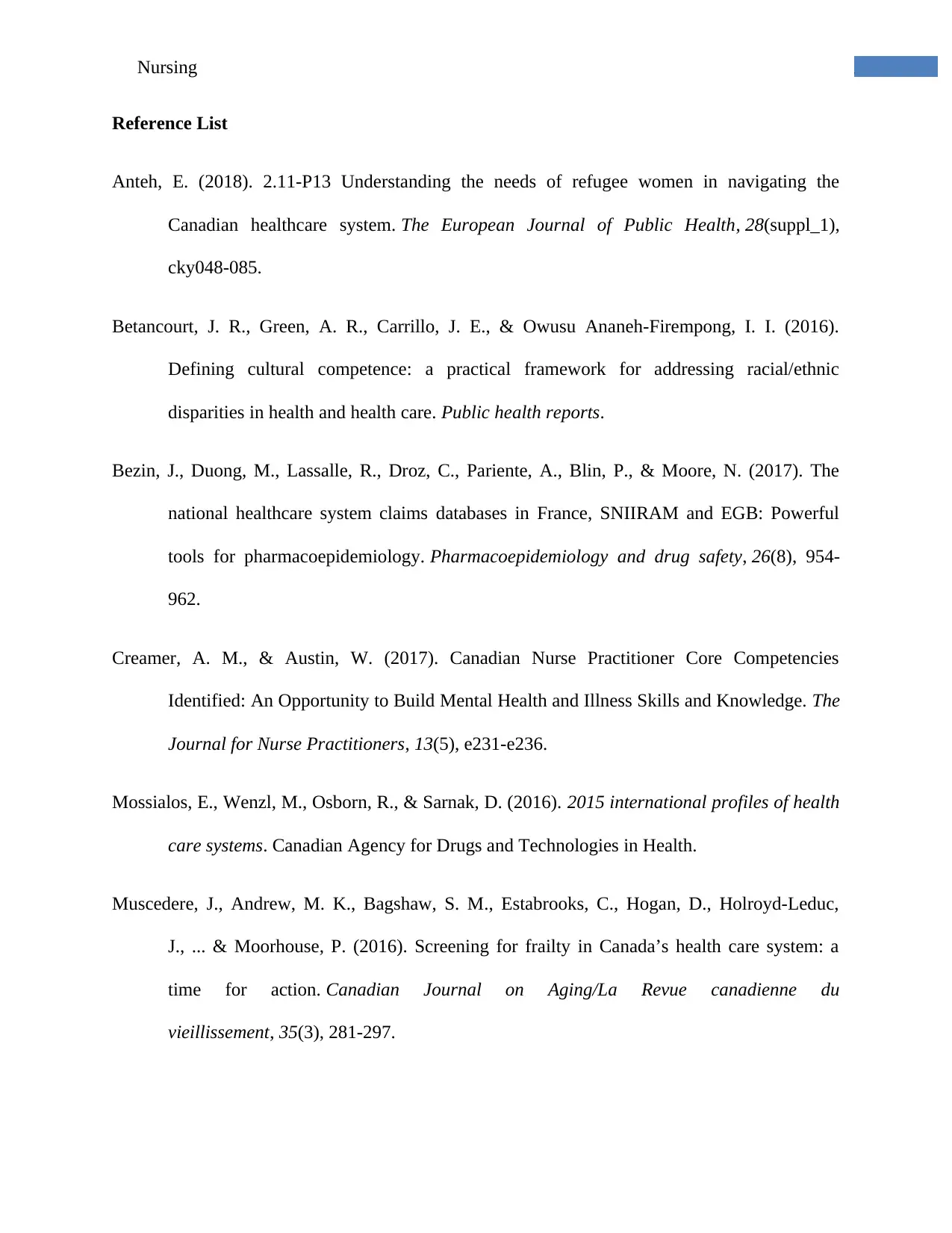
11Nursing
Reference List
Anteh, E. (2018). 2.11-P13 Understanding the needs of refugee women in navigating the
Canadian healthcare system. The European Journal of Public Health, 28(suppl_1),
cky048-085.
Betancourt, J. R., Green, A. R., Carrillo, J. E., & Owusu Ananeh-Firempong, I. I. (2016).
Defining cultural competence: a practical framework for addressing racial/ethnic
disparities in health and health care. Public health reports.
Bezin, J., Duong, M., Lassalle, R., Droz, C., Pariente, A., Blin, P., & Moore, N. (2017). The
national healthcare system claims databases in France, SNIIRAM and EGB: Powerful
tools for pharmacoepidemiology. Pharmacoepidemiology and drug safety, 26(8), 954-
962.
Creamer, A. M., & Austin, W. (2017). Canadian Nurse Practitioner Core Competencies
Identified: An Opportunity to Build Mental Health and Illness Skills and Knowledge. The
Journal for Nurse Practitioners, 13(5), e231-e236.
Mossialos, E., Wenzl, M., Osborn, R., & Sarnak, D. (2016). 2015 international profiles of health
care systems. Canadian Agency for Drugs and Technologies in Health.
Muscedere, J., Andrew, M. K., Bagshaw, S. M., Estabrooks, C., Hogan, D., Holroyd-Leduc,
J., ... & Moorhouse, P. (2016). Screening for frailty in Canada’s health care system: a
time for action. Canadian Journal on Aging/La Revue canadienne du
vieillissement, 35(3), 281-297.
Reference List
Anteh, E. (2018). 2.11-P13 Understanding the needs of refugee women in navigating the
Canadian healthcare system. The European Journal of Public Health, 28(suppl_1),
cky048-085.
Betancourt, J. R., Green, A. R., Carrillo, J. E., & Owusu Ananeh-Firempong, I. I. (2016).
Defining cultural competence: a practical framework for addressing racial/ethnic
disparities in health and health care. Public health reports.
Bezin, J., Duong, M., Lassalle, R., Droz, C., Pariente, A., Blin, P., & Moore, N. (2017). The
national healthcare system claims databases in France, SNIIRAM and EGB: Powerful
tools for pharmacoepidemiology. Pharmacoepidemiology and drug safety, 26(8), 954-
962.
Creamer, A. M., & Austin, W. (2017). Canadian Nurse Practitioner Core Competencies
Identified: An Opportunity to Build Mental Health and Illness Skills and Knowledge. The
Journal for Nurse Practitioners, 13(5), e231-e236.
Mossialos, E., Wenzl, M., Osborn, R., & Sarnak, D. (2016). 2015 international profiles of health
care systems. Canadian Agency for Drugs and Technologies in Health.
Muscedere, J., Andrew, M. K., Bagshaw, S. M., Estabrooks, C., Hogan, D., Holroyd-Leduc,
J., ... & Moorhouse, P. (2016). Screening for frailty in Canada’s health care system: a
time for action. Canadian Journal on Aging/La Revue canadienne du
vieillissement, 35(3), 281-297.
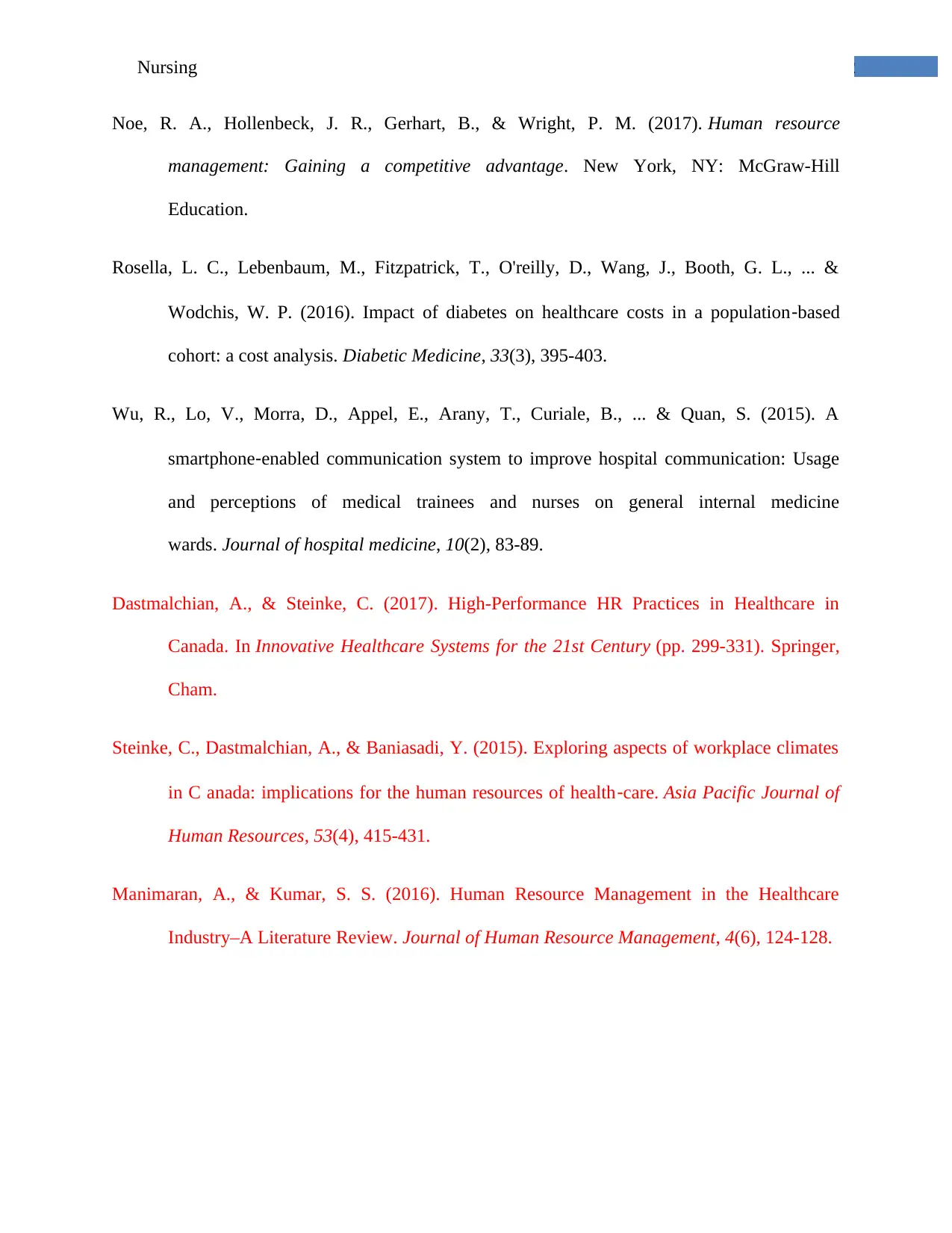
12Nursing
Noe, R. A., Hollenbeck, J. R., Gerhart, B., & Wright, P. M. (2017). Human resource
management: Gaining a competitive advantage. New York, NY: McGraw-Hill
Education.
Rosella, L. C., Lebenbaum, M., Fitzpatrick, T., O'reilly, D., Wang, J., Booth, G. L., ... &
Wodchis, W. P. (2016). Impact of diabetes on healthcare costs in a population‐based
cohort: a cost analysis. Diabetic Medicine, 33(3), 395-403.
Wu, R., Lo, V., Morra, D., Appel, E., Arany, T., Curiale, B., ... & Quan, S. (2015). A
smartphone‐enabled communication system to improve hospital communication: Usage
and perceptions of medical trainees and nurses on general internal medicine
wards. Journal of hospital medicine, 10(2), 83-89.
Dastmalchian, A., & Steinke, C. (2017). High-Performance HR Practices in Healthcare in
Canada. In Innovative Healthcare Systems for the 21st Century (pp. 299-331). Springer,
Cham.
Steinke, C., Dastmalchian, A., & Baniasadi, Y. (2015). Exploring aspects of workplace climates
in C anada: implications for the human resources of health‐care. Asia Pacific Journal of
Human Resources, 53(4), 415-431.
Manimaran, A., & Kumar, S. S. (2016). Human Resource Management in the Healthcare
Industry–A Literature Review. Journal of Human Resource Management, 4(6), 124-128.
Noe, R. A., Hollenbeck, J. R., Gerhart, B., & Wright, P. M. (2017). Human resource
management: Gaining a competitive advantage. New York, NY: McGraw-Hill
Education.
Rosella, L. C., Lebenbaum, M., Fitzpatrick, T., O'reilly, D., Wang, J., Booth, G. L., ... &
Wodchis, W. P. (2016). Impact of diabetes on healthcare costs in a population‐based
cohort: a cost analysis. Diabetic Medicine, 33(3), 395-403.
Wu, R., Lo, V., Morra, D., Appel, E., Arany, T., Curiale, B., ... & Quan, S. (2015). A
smartphone‐enabled communication system to improve hospital communication: Usage
and perceptions of medical trainees and nurses on general internal medicine
wards. Journal of hospital medicine, 10(2), 83-89.
Dastmalchian, A., & Steinke, C. (2017). High-Performance HR Practices in Healthcare in
Canada. In Innovative Healthcare Systems for the 21st Century (pp. 299-331). Springer,
Cham.
Steinke, C., Dastmalchian, A., & Baniasadi, Y. (2015). Exploring aspects of workplace climates
in C anada: implications for the human resources of health‐care. Asia Pacific Journal of
Human Resources, 53(4), 415-431.
Manimaran, A., & Kumar, S. S. (2016). Human Resource Management in the Healthcare
Industry–A Literature Review. Journal of Human Resource Management, 4(6), 124-128.
⊘ This is a preview!⊘
Do you want full access?
Subscribe today to unlock all pages.

Trusted by 1+ million students worldwide
1 out of 12
Related Documents
Your All-in-One AI-Powered Toolkit for Academic Success.
+13062052269
info@desklib.com
Available 24*7 on WhatsApp / Email
![[object Object]](/_next/static/media/star-bottom.7253800d.svg)
Unlock your academic potential
Copyright © 2020–2025 A2Z Services. All Rights Reserved. Developed and managed by ZUCOL.





